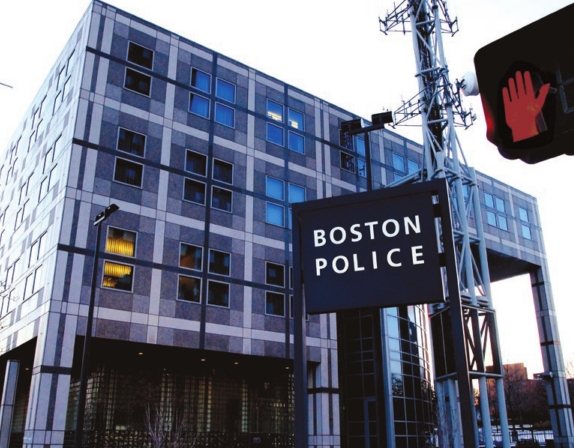

The Boston Police Department’s gang database lists 160 gangs and more than 5,300 gang members.
Hyde Park resident Domingos DaRosa, who owns a landscaping company, was dropping tools off at his mother’s Dorchester home on June 27, 2018 when he and his brother were shot by an unknown assailant. Grazed in the leg, he threw his brother over his shoulder, carried him to his landscaping truck and sped him to Boston Medical Center.
The next day, he was annoyed but not surprised when news outlets reported Boston police referring to the shooting as “gang-related.” DaRosa, who has never been a member of a gang, is nevertheless used to the label. He grew up with family on Wendover Street in Dorchester and was often told by police that he was a member of a gang.
“Every time I got stopped, it was the same thing,” he recalls. “‘You’re from Wendover.’ It was an excuse to stop me for no reason.”
He and his cousins played basketball together and hung out in a neighborhood many would describe as crime-infested, DaRosa said. But gang activity?
“We all hung out at the Daniel Marr Boy’s Club,” he recalls. “We played basketball at Clifford Park or Ronan Park. We never had issues with anyone.”
DaRosa, who is making his second run for an at-large city council seat, thinks the Boston Police Department’s Youth Violence Strike Force, commonly referred to as the gang unit, uses too broad a definition of what a gang is. The BPD’s gang database lists more than 5,300 people either active or inactive in 160 gangs, 100 of which are active. Information on the database obtained by the ACLU of Massachusetts suggests Boston police may have an overly expansive definition of what a gang is and who’s in a gang.
As a WBUR reporter noted last week, in Chicago, a city whose gang database came under fire for inaccuracies in recent years, just 59 gangs are listed. Given that Chicago has a population four times that of Boston, the figure of 160 gangs for Boston strains credibility, said attorney and Cornell Law School professor Carl Williams.
“That’s outrageous,” Williams said.
Part of the discrepancy could be explained by Boston Police Department’s Rule 335, which gives a broad official description in of what constitutes a gang:
“A group of three or more individuals, whether formal or informal, who has a common name or common identifying signs or colors or symbols or frequent a specific area or location and may claim it as their territory and has members or associates who, individually or collectively engage or have engaged in criminal activity which may involve incidents of targeting rival gang members and/or being targeted by rival gangs.”
DaRosa says that he and his cousins did not engage in criminal activity as a group nor consider themselves a gang, but under the BPD definition, individual acts by DaRosa or any of his cousins could have qualified them as a gang.
Yet, DaRosa notes, white kids aren’t subjected to the same level of scrutiny.
“The kids in Neponset are not considered a gang, but they’re outside drinking and smoking in Garvey Park every night,” he said. “It’s because they’re white kids. They’ll be 50 or 60 of them at any time after 6 p.m.”
Blacks account for 75 percent of the 5,300 names in BPD’s database, according to information BPD shared with the ACLU.
Non-black Latinos make up 14 percent and whites 2.3 percent. Just 26 people in the database are female.
Blacks make up about 23 percent of the city’s population. There are roughly 230,000 males living in Boston between the ages of 10 and 54 years old, according to information from the U.S. Census Bureau’s 2013-2017 American Community Survey. If 23 percent of them are black, that would equal roughly 53,000 black males in that age group. Of the 5,300 people in the BPD gang database, 75 percent, or approximately 3,975 of them are black males. That means that as many as 8 percent of black males between the ages of 10 and 54 living in Boston could be listed in the city’s gang database.
Those whose names are entered into the database typically are not notified that they are on the list. There’s no system for appealing such a designation or having one’s name removed, although the consequences of being listed can be dire. In 2018, a student at East Boston high school was taken into custody by federal immigration officials and deported after a police officer listed him as a gang member in an incident report.
Teens who are U.S. citizens have complained of increased harassment from police after they have been incorrectly listed as gang members by members of the Youth Violence Strike Force.
“When you have police driving around the neighborhood who aren’t from here, they think onein-ten kids is in a gang,” says attorney Carl Williams. “That’s why they’re doing stop-and-frisk. If you stop enough people, even if it’s one or two in a hundred who have contraband, it’s a terrible return rate, but the police feel justified.”
DaRosa says his son, who graduated from Boston College High School and was accepted to Bentley College, is treated like a gang member.
“The cops stop him and harass him any time they see him walking or driving,” he said.
The gang unit
The Youth Violence Strike Force is considered a prestigious assignment for officers, according to a police officer who spoke on the condition of anonymity.
“Specialized units are given more credit for the work they do than do regular patrolmen,” said the police source. “Usually, you get priority when opportunities for promotion come up.”
Eight members of the unit received three-day suspensions for drinking alcohol while on duty recently following a December 31, 2017 incident where a ninth officer, Domenic Columbo, slammed his pickup truck into a car, leaving a passenger with a severe brain injury.